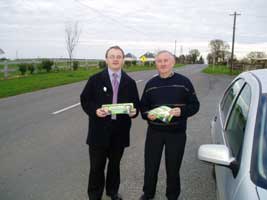31 March 2005 Edition
Two days until Údarás na Gaeltachta elections: But what's it all about? BY MICHELLE BOYLE

All-Ireland support: West Tyrone MLA Barry McElduff joins the election campaign in County Meath with local SF candidate for the Údaras elections, Seán MacDonncha
On Saturday 2 April the people of the Gaeltacht areas take pen to paper and decide who they want to represent them on the Board of Údarás na Gaeltachta, but, what's it all about, does it matter, and if elected what exactly does it mean?
What is Údaras Na Gaeltachta?
Udaras Na Gaeltacht is the Regional State Agency responsible for the economic and social development of the Gaeltacht so as to facilitate the preservation and extension of the Irish language as the principal language of the region. Údarás na Gaeltachta was established in 1980 under the Údarás na Gaeltachta Act, 1979, and builds on the work of its predecessor, Gaeltarra Éireann (1957-1979).
Gaeltachts (Irish speaking areas) are scattered over seven counties. Situated mainly along the Western seaboard, the board's sphere of influence covers extensive parts of Donegal, Kerry, Mayo and Galway and also parts of Cork, Meath and Waterford.
What are the Gaeltacht electorate voting for on 2 April?
Every five to seven years elections are held in these areas to determine who represents the people on the Board of Údarás na Gaeltachta. The board comprises of 20 members, 17 of whom are directly elected by the electorate of the Gaeltacht areas, the other three, including the Chairman, being appointed by the Minister for Community, Rural and Gaeltacht affairs. Those elected representative then make up a board of directors, which take on the responsibilities of Údarás na Gaeltachta.
What's the purpose of the Board of Údarás?
The Authority's work builds on the policies in maintaining and developing the Gaeltacht as a vibrant community where there is a sufficient level of economic activity to sustain the community and where the language is established at the heart of that economic activity.
The main areas of economic activity in the Gaeltacht are in electronics, engineering, information technology, film, television and video production, food processing, fish farming, rubber and plastics manufacturing. A maximum of 12.5% corporation tax applies for manufacturing industry. This is fixed to the year 2010 and has been guaranteed by the government with the agreement of the European Commission.
What can Sinn Féin gain from being represented on the board?
Sinn Féin has never held a seat on the Board of Údarás na Gaeltachta.
Apart from the obvious political strength that would be gained, once on the board the party would then have a say in decisions that are made about the Gaeltacht. It would be very fitting on our 100th anniversary to take a seat on this body. For many years now, the Gaeltacht areas have been abused and mismanaged. We have witnessed huge unemployment rates (the Donegal Gaeltacht has three times the national rate), sizeable economic decline and seen the decay of the Irish language.
By having representation on the board we will know what decisions are being taking internally, be able to take steps to rectify the current state these areas are in and help prevent the situation getting any worse.
As a party that prides itself on promoting culture and language it is vital that we are represented. In addition, it is another barrier we will have broken, taking us another step toward Irish unity.
What steps are we taking to get elected to the Board?
Sinn Féin is contesting seats in three areas: Donegal, Galway and Meath.
DONEGAL
• 7 candidates running for 4 seats.
• There is an electorate of 23,211.
• Those parties currently holding seats are 2 Fianna Fail, 1 Fine Gael, 1 Independent Fianna Fail.
Gráinne Mhic Géidigh is the Sinn Féin candidate. If elected, she would be the first woman elected to the board in Donegal.
GALWAY
• 20 candidates are running for 6 seats.
• There is an electorate of 33,046.
• Those parties currently holding seats are 4 Fianna Fáil, 1 Independent, 1 Fine Gael.
Colm Ó Ceannabháin is the Sinn Féin candidate.
MEATH
• 4 candidates are running for 1 seat.
• There is an electorate of approximately 1,500.
• An Independent candidate currently holds the seat.
Seán Mac Donnchadh is the Sinn Féin candidate.


